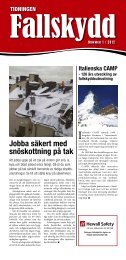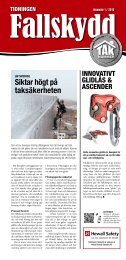RAILSTOP RS-S05 - Hewall Safety Sweden AB
RAILSTOP RS-S05 - Hewall Safety Sweden AB
RAILSTOP RS-S05 - Hewall Safety Sweden AB
You also want an ePaper? Increase the reach of your titles
YUMPU automatically turns print PDFs into web optimized ePapers that Google loves.
• The suspension point for the rope protection<br />
needs to be adequately strong (EN 795) and<br />
positioned correctly. If possible, a suspension<br />
point overhead should be selected.<br />
• Select the highest possible suspension<br />
point.<br />
• When using this PPE as a fall arrest system<br />
(freefall is possible), a harness in accordance<br />
with EN 361 must always be used.<br />
• The possible freefall height must be kept as<br />
short as possible. The whole possible fall<br />
path should be noted. There is a risk of hitting<br />
protruding building parts or even the<br />
ground. There is a risk of injury when swinging<br />
after a fall.<br />
• With fall arrest systems, it is imperative for<br />
safety that, every time before the system is<br />
used, steps are taken to check that the required<br />
clearance below the user has been<br />
calculated adequately to ensure that, in case<br />
of a fall, the person cannot impact a protruding<br />
obstacle or hit the ground.<br />
• When using the personal protection equipment<br />
vertically (as designated in EN 353-1,<br />
EN 353-2, etc.) note that within the required<br />
clearance, impact with the ground cannot<br />
be ruled out.<br />
For this reason, special care must be taken<br />
within the first 2 metres above ground.<br />
• Possible fall distance if all the required PPE<br />
components are used properly: Braking distance<br />
energy absorber (max. 175 cm) + (if<br />
nec. reaction time HSG) + body height (clearance<br />
height of the PPE) + safety reserve 1 m<br />
<strong>Safety</strong> ProviSionS<br />
• Protect the PPE during storage, use or transportation<br />
against the effects of heat (e. g.<br />
welding flames or sparks, hot cigarette ash)<br />
and chemicals (acids, lyes, oils, etc.) and mechanical<br />
influences (sharp edges etc).<br />
• Before work is commenced, an emergency<br />
plan (rescue plan) needs to be drawn up for<br />
the respective work situation by the responsible<br />
person stating how a person who has<br />
fallen can be safely and quickly rescued from<br />
a hanging position and first aid administered.<br />
Rescue actions like this need to be<br />
performed within 10 to 30 minutes. BOR-<br />
NACK assists you here by drawing up tailored<br />
rescue plans and incorporating your<br />
rescue plan into the training courses.<br />
hotline@bornack.de<br />
• The local safety regulations (e. g. in Germany<br />
the BGR regulations BGR 198, 199 of the professional<br />
associations) and the relevant industry-specific<br />
accident prevention regulations<br />
are to be observed.<br />
• The temperature range for using the textile<br />
personal protection equipment against falling<br />
is +80 °C to –40 °C. The temperatures for<br />
personal protection equipment systems can<br />
be found in Part 1 of the user manual<br />
• The PPE must be inspected at least once a<br />
year by an authorised person. The result of<br />
this must be documented in the inspection<br />
card.<br />
DE<br />
UK<br />
FR<br />
IT<br />
ES<br />
NL<br />
PT<br />
GR<br />
NO<br />
SE<br />
TR<br />
HU<br />
RU<br />
RO<br />
EE<br />
LV<br />
LT<br />
HR<br />
PL<br />
CZ<br />
BG<br />
FI




